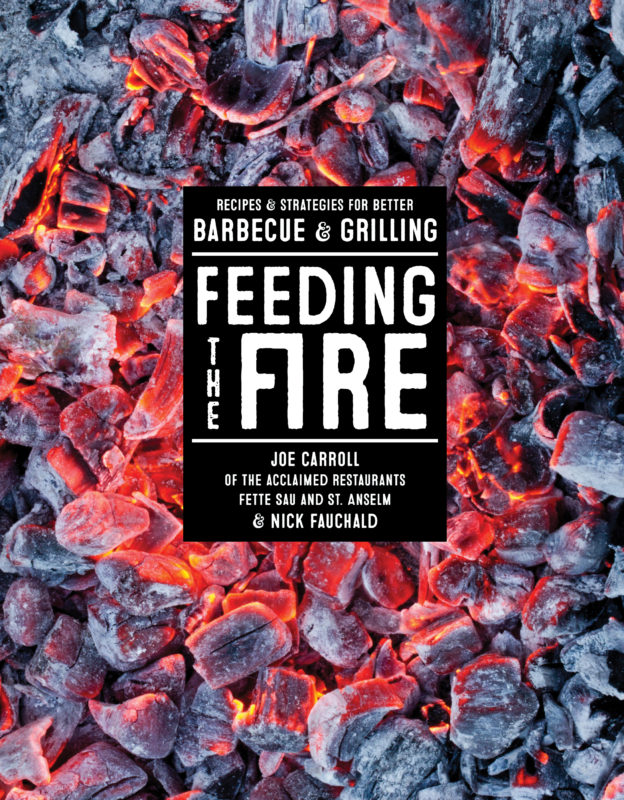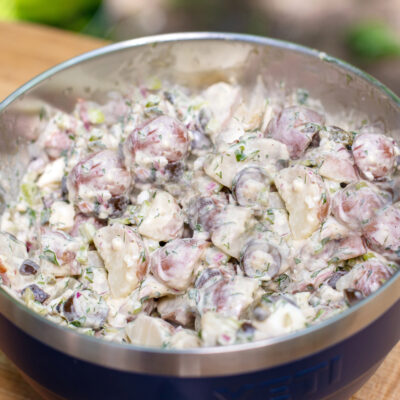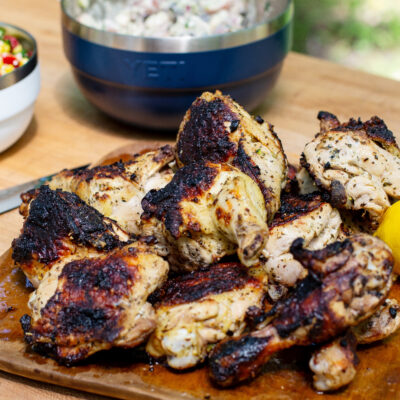Axe-Handle Rib-Eye Steak
By Joe Carroll
This beefy behemoth might look and sound intimidating, but it’s just like any other rib-eye steak, except that it has a full rib attached and it’s twice as thick as usual. This is the steak you serve to folks who think they’ve tried everything a cow has to offer. At St. Anselm, our meat comes from the incredibly marbled American Wagyu cattle at the Masami Cattle Ranch in California. If you have a good butcher and ask nicely, he may be able to prepare one of these for you (many butchers will know this as a “cowboy chop”). If not, ask for a double-cut rib-eye steak and don’t worry about skipping the extra length of bone—only your dog will miss it.
When cooking a Flintstones-size steak like this, you have to take extra care to achieve a deeply charred crust and a properly cooked interior. At home, I sear it first, to make sure it gets enough char, then grill it to temperature over low heat. At the restaurant, the cooks do the opposite: they cook the steak over low heat until it reaches 115°F (for medium-rare) and let it rest until they’re ready to finish it off, then quickly grill it over scorching-high heat until it’s charred all over and serve it immediately—no additional resting necessary. This is what’s called a “reverse sear.” Use this method if you want to cook your rib-eye up to an hour ahead of time, but be careful to not overcook it during the low-heat phase, or you’ll end up with a well-done piece of meat after you sear it.
Recipe from Feeding the Fire by Joe Carroll & Nick Fauchald. Order your copy here.
Joe Carroll’s Axe-Handle Rib-Eye Steak
Ingredients
- One axe-handle rib-eye steak (2 1/2 to 3 3/4 pounds), about 2 inches thick
- Kosher salt and freshly ground black pepper
- 1/4 cup melted Garlic Butter (recipe below) or 4 tablespoons unsalted butter, melted
- Flaky sea salt, such as Maldon
Garlic Butter
- 1/2 pound (2 sticks) unsalted butter, cubed
- 6 garlic cloves, finely chopped
Instructions
Start charcoal and let burn until coals are glowing red and coated in gray ash, about 15 minutes. You can create two heat zones by adding different amounts of coals to each side of the grill (or leaving one half of the grill coal-free to create a cool side). For a medium-high zone, build a layer about one to two coal deep; for low, scatter a few coals evenly over that side. Oil the grate well. Have a spray bottle handy to extinguish any large flare-ups; it’s OK for flames to lick the steak now and then, but they shouldn’t slobber it with kisses.
Generously shower the steak with kosher salt and pepper (this will probably be the most you season any piece of meat in your life). Grill the steak over high heat, moving it and turning it every minute or so, until it’s well charred on both sides and around the perimeter, 8 to 10 minutes.
Move the steak to the low-heat side of the grill and cook until an instant-read thermometer inserted into the center of the meat registers 125°F for medium-rare, 20 to 30 minutes, depending on the size of your steak. Transfer the steak to a platter and let rest for 10 minutes.
If the surface of the steak is moist with juices after resting, quickly sear the steak on both sides over high heat to crisp up the crust, about 30 seconds per side.
Transfer the steak to a platter. You can either carve the steak as you eat, family-style or divide it into portions by first cutting the meat away from the bone, then carving the steak across the grain into large pieces. Serve with the melted butter and flaky salt on the side.
Garlic Butter
Makes about 1 cup
In a saucepan, melt the butter over low heat. Add the garlic and cook over medium-low heat for 5 minutes; the butter should simmer gently but not brown. Remove from the heat.
Skim the foam from the top of the butter and slowly pour the butter through a fine-mesh sieve set over a bowl. Discard the milky solids and garlic. The butter can be refrigerated for up to 3 weeks.
Excerpted from Feeding the Fire by Joe Carroll and Nick Fauchald (Artisan Books). Copyright © 2015. Photographs by William Hereford.








